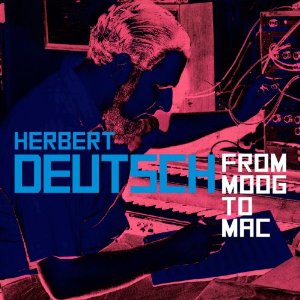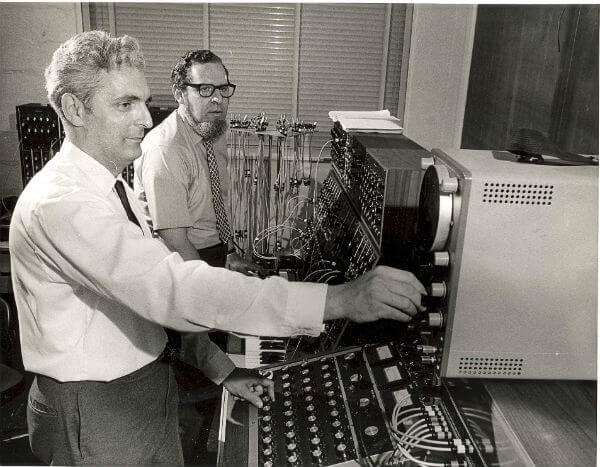 From Moog to Mac sets about curating a documentation of processes, experimentation, and resulting effects that were crafted in the musical alliance between Dr. Herbert Deutsch and Robert Moog after they assembled the world’s first voltage-controlled synthesizer. The album embodies a chronological catalog of instances in development; it formulates segues into the project’s initiation and the advancement of a gadget, which to paraphrase its technical creator, would sound much better when played by someone with more of an imagination. Deutsch turned out to be the man who exemplified just the right amount of artistry, and so, after a single meeting at New York State School Music Association, this great collaboration of minds was instigated and the inquisitive duo set about transforming Moog’s invention into a device that could be played as a musical instrument. These recordings operate as a testament to that partnership through exploring a range of stylistic frameworks. They also keep tabs on the machine’s progressive interaction with people while it accompanies cabaret singers, looped news broadcasts and the opening lines to Shakespeare’s Richard III. The resulting tracks map the synthesizer’s journey across an exciting spectrum of electronic music, which in the case of the Moog synth, began in September 1964.
From Moog to Mac sets about curating a documentation of processes, experimentation, and resulting effects that were crafted in the musical alliance between Dr. Herbert Deutsch and Robert Moog after they assembled the world’s first voltage-controlled synthesizer. The album embodies a chronological catalog of instances in development; it formulates segues into the project’s initiation and the advancement of a gadget, which to paraphrase its technical creator, would sound much better when played by someone with more of an imagination. Deutsch turned out to be the man who exemplified just the right amount of artistry, and so, after a single meeting at New York State School Music Association, this great collaboration of minds was instigated and the inquisitive duo set about transforming Moog’s invention into a device that could be played as a musical instrument. These recordings operate as a testament to that partnership through exploring a range of stylistic frameworks. They also keep tabs on the machine’s progressive interaction with people while it accompanies cabaret singers, looped news broadcasts and the opening lines to Shakespeare’s Richard III. The resulting tracks map the synthesizer’s journey across an exciting spectrum of electronic music, which in the case of the Moog synth, began in September 1964.
The first piece ever to be composed using the sound of the Moog was Deutsch’s Jazz Images, A Worksong and Blues, which features a cautious interplay of synth modulation and improvised piano with trumpet. It’s curious that this is where Deutsch begins his journey, by accompanying analogue transitions with instruments he had been playing since childhood – yet the acoustic instrumentation wonderfully compliments its electronic counterpart. Coincidentally, this particular number is in a minority that can be listened to straight off the cuff, as an interesting piece separated from the sonic chronicling this collective body of work purports to. The preceding track, Abomination, comprises of an informal and humorous presentation of equipment by Robert Moog to his musical co-conspirator. It provides a fascinating insight into the ideas conceived by Moog, who was attempting, among other things, to manufacture a product that would somehow convert physical connections in the space separating the theremin and the musician through piano keys, which could be fingered in order to generate sound. It is a spectacular recording and a wonderful moment on the album that defines a key instance when electronic music began to take its initial steps in the human mind.
 However, not every track works as well in this regard; Sleight of Hand (Mister Magic Man), for example, is a rather grotesque lounge pop song that dilly-dallys in its own frightful tedium before fading away into nothingness. The reason for its inclusion here, one assumes, is to map affinities the natural voice shares with the synthesizer, while simultaneously showcasing the versatility of the machine at stake. However, the song is drawn out, stuffy, and redundant. The following tune, Abyss, manages to illustrate the same points in a much more humbling way, retaining a sense of context among the abundantly experimental efforts. Indeed, the more unconventional tracks are what make for the most engrossing listens. Little Night Music, The Ithaca Journal Aug. 6, 1965 slices Beethoven with fragments of pulsating glitch and early noise renditions – it switches in style, focus and even genre by showcasing the dexterity of the synthesizer and its curious evolution. The score is irregular and disjointed, amplifying both the potential of the contraption at hand as well as Deutsch’s aptitude as an electronic-acoustic composer; it highlights his exceptional capabilities as a musician while emphasizing the central reason for his being integral to Moog’s design.
However, not every track works as well in this regard; Sleight of Hand (Mister Magic Man), for example, is a rather grotesque lounge pop song that dilly-dallys in its own frightful tedium before fading away into nothingness. The reason for its inclusion here, one assumes, is to map affinities the natural voice shares with the synthesizer, while simultaneously showcasing the versatility of the machine at stake. However, the song is drawn out, stuffy, and redundant. The following tune, Abyss, manages to illustrate the same points in a much more humbling way, retaining a sense of context among the abundantly experimental efforts. Indeed, the more unconventional tracks are what make for the most engrossing listens. Little Night Music, The Ithaca Journal Aug. 6, 1965 slices Beethoven with fragments of pulsating glitch and early noise renditions – it switches in style, focus and even genre by showcasing the dexterity of the synthesizer and its curious evolution. The score is irregular and disjointed, amplifying both the potential of the contraption at hand as well as Deutsch’s aptitude as an electronic-acoustic composer; it highlights his exceptional capabilities as a musician while emphasizing the central reason for his being integral to Moog’s design.
For the casual listener, this might be a tricky album to navigate. The experience revolves solely around the audio archiving of the electronic synthesizer’s progress up until 2007, where the record closes with two quite brilliant compositions for theremin and piano. It is by no means an accident that these pieces are used to conclude, for they refer to the fascination Robert Moog had for the theremin, as well as the role it played in bringing his synthesizer to life. Amid the odd gathering of abstract formulas presented here, both Moog and Deutsch explore the blossoming relationship between human beings, new technology, and acoustic instruments. Not only that, but Deutsch appears to be testing the water throughout each inclusion by establishing just how far he can take this new and exciting instrument in exploring the boundaries of the music he has done so much to establish.
Herbert Deutsch, From Moog to Mac (Ravello Records, October 2012) | Buy on Amazon
–
Daniel is a documentary filmmaker and writer currently residing in London. Follow him on Twitter: @danielemmerson.
























